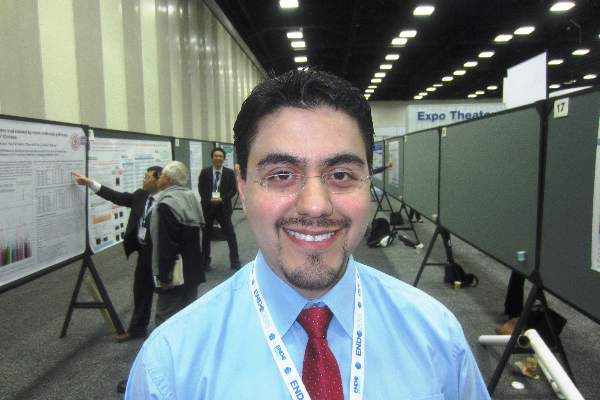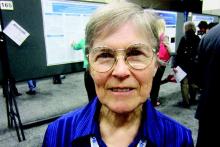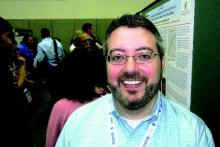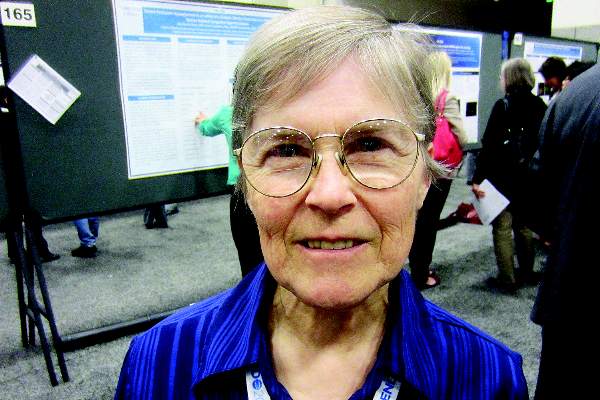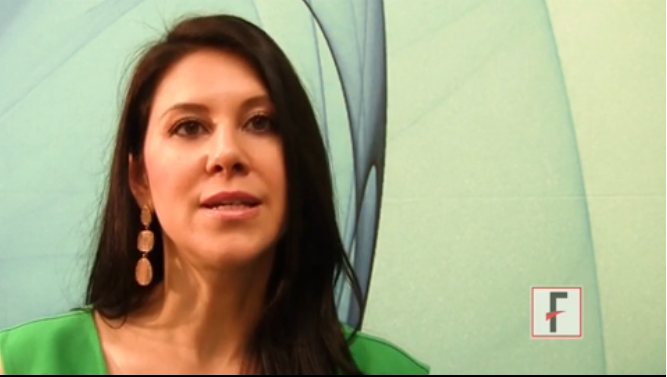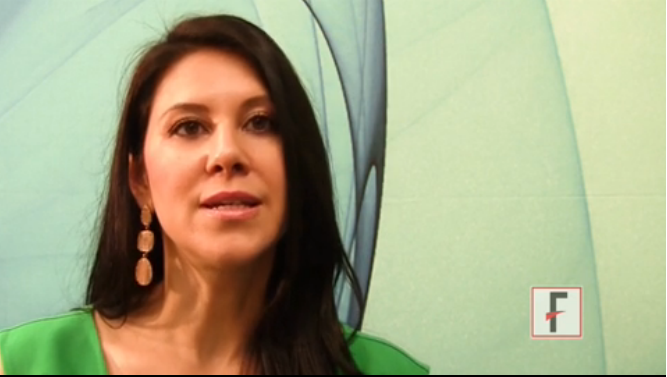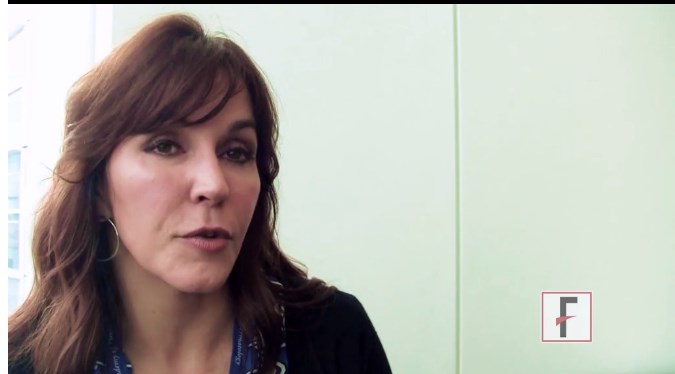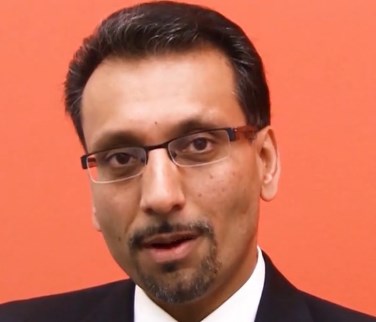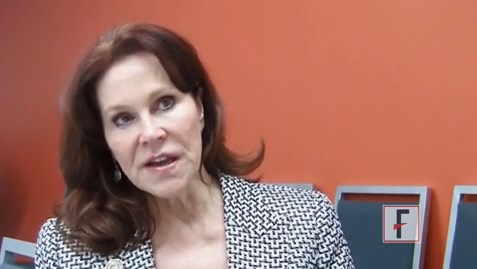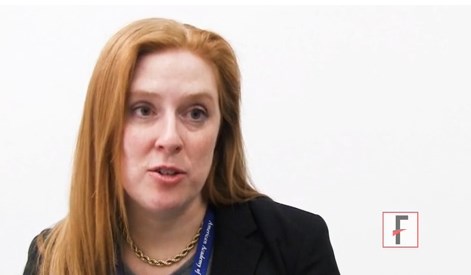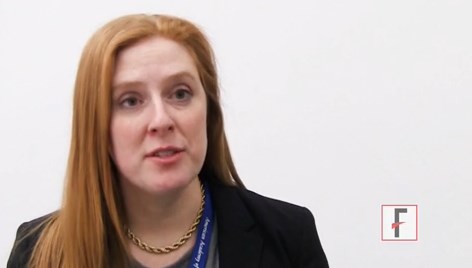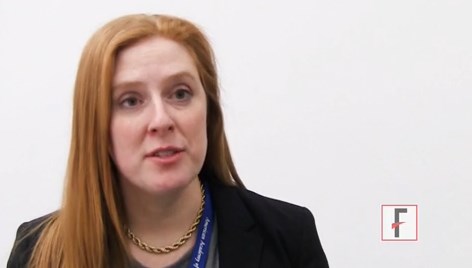User login
M. Alexander Otto began his reporting career early in 1999 covering the pharmaceutical industry for a national pharmacists' magazine and freelancing for the Washington Post and other newspapers. He then joined BNA, now part of Bloomberg News, covering health law and the protection of people and animals in medical research. Alex next worked for the McClatchy Company. Based on his work, Alex won a year-long Knight Science Journalism Fellowship to MIT in 2008-2009. He joined the company shortly thereafter. Alex has a newspaper journalism degree from Syracuse (N.Y.) University and a master's degree in medical science -- a physician assistant degree -- from George Washington University. Alex is based in Seattle.
Pamphlet helped Graves’ patients find peace with treatment choices
San Diego – Graves’ disease patients are more comfortable with their treatment decisions when doctors walk them through the options with a short pamphlet being developed at the Mayo Clinic in Rochester, Minn.
None of the three treatment options for Graves’ – thyroidectomy, radioactive iodine, and antithyroid drugs – is clearly superior to the others. That usually means that patients end up getting whatever treatment their institution prefers, and not so much making the choice themselves, said lead investigator Dr. Juan Brito, an assistant endocrinology professor at the Mayo Clinic.
That approach isn’t going to work much longer as patient involvement and satisfaction come online as quality metrics, Dr. Brito noted.
Shared decision making has been a theme at Mayo for a while now, he said, and the institution has developed and validated a range of “decision-making tools” for patients with various diseases. The Graves’ diseasepamphlet is among its latest efforts.
“We don’t really care if patients make a decision for surgery, medicine, or radioactive iodine,” said Dr. Brito. “What we care about is that patients know what they are doing, are more involved in the process, and more satisfied with their decisions.
“We want patients to decide, not the institution,” added Dr. Brito, who noted that Mayo has traditionally been a radioactive iodine institution.
The Graves’ decision pamphlet lays out the pros and cons of all three options – effectiveness, costs, number of follow-up visits, likelihood of thyroid replacement, eye complications, and the like – using five easy-to-understand graphics. The goal is for doctors to use the pamphlet during consultations to ensure that all the bases are covered and patients understand what they hear. The pamphlet doesn’t make consults longer, Dr. Brito noted – if anything, it shortens them a bit.
To assess the pamphlet’s effectiveness, Dr. Brito and his team surveyed patients after their encounters.
The 19 patients guided through their options with the “Graves’ Disease Treatment Choice” pamphlet were more involved with decisions than the 33 patients who were not, as measured by the OPTION [observing patient involvement in decision making] scale (mean score 38.5 points versus 30.8, with 100 points indicating the greatest involvement, P = 0.02).
Pamphlet patients also were more certain of their decisions, as assessed by the Decisional Conflict Scale (19 points versus 31 points, with 0 points being complete certainty, P = 0.19). The length of the discussion was slightly shorter with the pamphlet (37 minutes versus 39 minutes), but the difference was not significant.
Pamphlet patients also seemed more knowledgeable about treatment side effects, and were more likely to choose radioactive iodine and less likely to choose antithyroid drugs; but the differences in what they opted for were also not significant.
On average, patients were in their early 40s, and three-quarters were women.
The decision tool “improves patient involvement in decision making about treatment options without increasing the length of the consultation,” Dr. Brito explained. “This tool helps the patient and clinician navigate through the options and enhances the quality of the process.”
The investigators have no disclosures and no outside funding for their work.
San Diego – Graves’ disease patients are more comfortable with their treatment decisions when doctors walk them through the options with a short pamphlet being developed at the Mayo Clinic in Rochester, Minn.
None of the three treatment options for Graves’ – thyroidectomy, radioactive iodine, and antithyroid drugs – is clearly superior to the others. That usually means that patients end up getting whatever treatment their institution prefers, and not so much making the choice themselves, said lead investigator Dr. Juan Brito, an assistant endocrinology professor at the Mayo Clinic.
That approach isn’t going to work much longer as patient involvement and satisfaction come online as quality metrics, Dr. Brito noted.
Shared decision making has been a theme at Mayo for a while now, he said, and the institution has developed and validated a range of “decision-making tools” for patients with various diseases. The Graves’ diseasepamphlet is among its latest efforts.
“We don’t really care if patients make a decision for surgery, medicine, or radioactive iodine,” said Dr. Brito. “What we care about is that patients know what they are doing, are more involved in the process, and more satisfied with their decisions.
“We want patients to decide, not the institution,” added Dr. Brito, who noted that Mayo has traditionally been a radioactive iodine institution.
The Graves’ decision pamphlet lays out the pros and cons of all three options – effectiveness, costs, number of follow-up visits, likelihood of thyroid replacement, eye complications, and the like – using five easy-to-understand graphics. The goal is for doctors to use the pamphlet during consultations to ensure that all the bases are covered and patients understand what they hear. The pamphlet doesn’t make consults longer, Dr. Brito noted – if anything, it shortens them a bit.
To assess the pamphlet’s effectiveness, Dr. Brito and his team surveyed patients after their encounters.
The 19 patients guided through their options with the “Graves’ Disease Treatment Choice” pamphlet were more involved with decisions than the 33 patients who were not, as measured by the OPTION [observing patient involvement in decision making] scale (mean score 38.5 points versus 30.8, with 100 points indicating the greatest involvement, P = 0.02).
Pamphlet patients also were more certain of their decisions, as assessed by the Decisional Conflict Scale (19 points versus 31 points, with 0 points being complete certainty, P = 0.19). The length of the discussion was slightly shorter with the pamphlet (37 minutes versus 39 minutes), but the difference was not significant.
Pamphlet patients also seemed more knowledgeable about treatment side effects, and were more likely to choose radioactive iodine and less likely to choose antithyroid drugs; but the differences in what they opted for were also not significant.
On average, patients were in their early 40s, and three-quarters were women.
The decision tool “improves patient involvement in decision making about treatment options without increasing the length of the consultation,” Dr. Brito explained. “This tool helps the patient and clinician navigate through the options and enhances the quality of the process.”
The investigators have no disclosures and no outside funding for their work.
San Diego – Graves’ disease patients are more comfortable with their treatment decisions when doctors walk them through the options with a short pamphlet being developed at the Mayo Clinic in Rochester, Minn.
None of the three treatment options for Graves’ – thyroidectomy, radioactive iodine, and antithyroid drugs – is clearly superior to the others. That usually means that patients end up getting whatever treatment their institution prefers, and not so much making the choice themselves, said lead investigator Dr. Juan Brito, an assistant endocrinology professor at the Mayo Clinic.
That approach isn’t going to work much longer as patient involvement and satisfaction come online as quality metrics, Dr. Brito noted.
Shared decision making has been a theme at Mayo for a while now, he said, and the institution has developed and validated a range of “decision-making tools” for patients with various diseases. The Graves’ diseasepamphlet is among its latest efforts.
“We don’t really care if patients make a decision for surgery, medicine, or radioactive iodine,” said Dr. Brito. “What we care about is that patients know what they are doing, are more involved in the process, and more satisfied with their decisions.
“We want patients to decide, not the institution,” added Dr. Brito, who noted that Mayo has traditionally been a radioactive iodine institution.
The Graves’ decision pamphlet lays out the pros and cons of all three options – effectiveness, costs, number of follow-up visits, likelihood of thyroid replacement, eye complications, and the like – using five easy-to-understand graphics. The goal is for doctors to use the pamphlet during consultations to ensure that all the bases are covered and patients understand what they hear. The pamphlet doesn’t make consults longer, Dr. Brito noted – if anything, it shortens them a bit.
To assess the pamphlet’s effectiveness, Dr. Brito and his team surveyed patients after their encounters.
The 19 patients guided through their options with the “Graves’ Disease Treatment Choice” pamphlet were more involved with decisions than the 33 patients who were not, as measured by the OPTION [observing patient involvement in decision making] scale (mean score 38.5 points versus 30.8, with 100 points indicating the greatest involvement, P = 0.02).
Pamphlet patients also were more certain of their decisions, as assessed by the Decisional Conflict Scale (19 points versus 31 points, with 0 points being complete certainty, P = 0.19). The length of the discussion was slightly shorter with the pamphlet (37 minutes versus 39 minutes), but the difference was not significant.
Pamphlet patients also seemed more knowledgeable about treatment side effects, and were more likely to choose radioactive iodine and less likely to choose antithyroid drugs; but the differences in what they opted for were also not significant.
On average, patients were in their early 40s, and three-quarters were women.
The decision tool “improves patient involvement in decision making about treatment options without increasing the length of the consultation,” Dr. Brito explained. “This tool helps the patient and clinician navigate through the options and enhances the quality of the process.”
The investigators have no disclosures and no outside funding for their work.
AT ENDO 2015
Key clinical point: It’s possible to increase patient involvement in treatment decisions without increasing length of consultations.
Major finding: The 19 Graves’ patients guided through treatment options with a Mayo Clinic Graves’ pamphlet were more involved with decision making than the 33 who were not, as measured by the OPTION scale (mean score 38.5 points versus 30.8, with 100 points indicating the greatest involvement, P = 0.02).
Data source: Surveys of 55 Graves’ disease patients.
Disclosures: The investigators have no disclosures and no outside funding for their work.
Long-term endocrine effects common after reduced-intensity chemotherapy in children
SAN DIEGO – Remain vigilant for endocrine side effects after reduced-intensity conditioning for hematopoietic stem cell transplants in children.
Traditionally, hematopoietic stem cell transplants (HSCT) for leukemia and other malignancies are preceded by myeloablation with high-dose chemotherapy and radiation. Over the past decade, however, that approach has been supplanted by reduced-intensity conditioning (RIC), a gentler method for less aggressive diseases that don’t require a cancer to be wiped out before HSCT. RIC usually involves low-dose chemotherapy without radiation.
The hope is to reduce side effects with the gentler approach, but that’s not always how it works, according to a retrospective study of 120 children followed for a mean of 3.2 years at the Cincinnati Children’s Hospital Medical Center, which was presented at a poster session at the meeting of the Endocrine Society.
The children had RIC with campath, fludarabine, and melphalan – but no radiation – prior to one HSCT for hemophagocytic lymphohistiocytosis/X-linked lymphoproliferative syndrome (HLH/XLP), primary immune deficiency, or other generally nonmalignant conditions.
During follow-up, almost a quarter had thyroid problems and nearly three-fourths were vitamin-D deficient. Children less than 2 years old when transplanted started to catch up to their peers on growth charts, but children over 2 years old fell further behind. Hypogonadism might be a problem, too; the investigators plan to follow the children to see how they fare during puberty.
“We were surprised” by the results, said senior investigator Dr. Susan Rose, professor of endocrinology at the University of Cincinnati.
“We really thought that, with [RIC], not as many of them would have problems after their transplants, and they would grow better. [Many] were coming off steroids” after the procedure, “which usually leads children to have catch-up growth. Instead, we are seeing their growth is slower than normal. The occurrence of endocrinopathy after [RIC] is probably lower than with high-dose chemotherapy combined with radiation, but we still have to monitor [these children] and not be cavalier” about follow-up, she said.
“We can’t expect there to be no or fewer endocrine complications just because there was a less intensive [conditioning] regimen. We must, as endocrinologists, be vigilant about monitoring and screening” these patients, said endocrinologist and lead author Dr. Jonathan Howell, assistant professor of pediatrics at the university.
The children were an average of 6 years old when transplanted. They were shorter than average both before (height-for-age Z-score [HAZ] = –1.33) and after (HAZ = –1.35).
Children with HLH/XLP who were under 2 years old at transplant improved from an HAZ of –3.36 to –1.35 afterwards, but older children fell from an HAZ of –0.61 to –0.99.
Older children with HLH/XLP lost weight after transplant (body mass index Z-score [BMI-Z], 1.29 vs. 0.61), as did those transplanted for metabolic or genetic disorders (BMI-Z, 0.56 vs. –0.77). There was a trend towards increased BMI-Z in toddlers.
Seventy-seven children had their thyroids checked after HSCT: 11 had primary hypothyroidism, five had central hypothyroidism, and two were hyperthyroid. Also, 48 of the 68 children assessed for 25-OH vitamin D had levels below 30 ng/mL.
Fourteen children broke bones after their transplants and six were diagnosed with avascular necrosis. The team is looking into whether it had something to do with endocrine dysfunction.
The investigators had no disclosures and no external funding for their work.
SAN DIEGO – Remain vigilant for endocrine side effects after reduced-intensity conditioning for hematopoietic stem cell transplants in children.
Traditionally, hematopoietic stem cell transplants (HSCT) for leukemia and other malignancies are preceded by myeloablation with high-dose chemotherapy and radiation. Over the past decade, however, that approach has been supplanted by reduced-intensity conditioning (RIC), a gentler method for less aggressive diseases that don’t require a cancer to be wiped out before HSCT. RIC usually involves low-dose chemotherapy without radiation.
The hope is to reduce side effects with the gentler approach, but that’s not always how it works, according to a retrospective study of 120 children followed for a mean of 3.2 years at the Cincinnati Children’s Hospital Medical Center, which was presented at a poster session at the meeting of the Endocrine Society.
The children had RIC with campath, fludarabine, and melphalan – but no radiation – prior to one HSCT for hemophagocytic lymphohistiocytosis/X-linked lymphoproliferative syndrome (HLH/XLP), primary immune deficiency, or other generally nonmalignant conditions.
During follow-up, almost a quarter had thyroid problems and nearly three-fourths were vitamin-D deficient. Children less than 2 years old when transplanted started to catch up to their peers on growth charts, but children over 2 years old fell further behind. Hypogonadism might be a problem, too; the investigators plan to follow the children to see how they fare during puberty.
“We were surprised” by the results, said senior investigator Dr. Susan Rose, professor of endocrinology at the University of Cincinnati.
“We really thought that, with [RIC], not as many of them would have problems after their transplants, and they would grow better. [Many] were coming off steroids” after the procedure, “which usually leads children to have catch-up growth. Instead, we are seeing their growth is slower than normal. The occurrence of endocrinopathy after [RIC] is probably lower than with high-dose chemotherapy combined with radiation, but we still have to monitor [these children] and not be cavalier” about follow-up, she said.
“We can’t expect there to be no or fewer endocrine complications just because there was a less intensive [conditioning] regimen. We must, as endocrinologists, be vigilant about monitoring and screening” these patients, said endocrinologist and lead author Dr. Jonathan Howell, assistant professor of pediatrics at the university.
The children were an average of 6 years old when transplanted. They were shorter than average both before (height-for-age Z-score [HAZ] = –1.33) and after (HAZ = –1.35).
Children with HLH/XLP who were under 2 years old at transplant improved from an HAZ of –3.36 to –1.35 afterwards, but older children fell from an HAZ of –0.61 to –0.99.
Older children with HLH/XLP lost weight after transplant (body mass index Z-score [BMI-Z], 1.29 vs. 0.61), as did those transplanted for metabolic or genetic disorders (BMI-Z, 0.56 vs. –0.77). There was a trend towards increased BMI-Z in toddlers.
Seventy-seven children had their thyroids checked after HSCT: 11 had primary hypothyroidism, five had central hypothyroidism, and two were hyperthyroid. Also, 48 of the 68 children assessed for 25-OH vitamin D had levels below 30 ng/mL.
Fourteen children broke bones after their transplants and six were diagnosed with avascular necrosis. The team is looking into whether it had something to do with endocrine dysfunction.
The investigators had no disclosures and no external funding for their work.
SAN DIEGO – Remain vigilant for endocrine side effects after reduced-intensity conditioning for hematopoietic stem cell transplants in children.
Traditionally, hematopoietic stem cell transplants (HSCT) for leukemia and other malignancies are preceded by myeloablation with high-dose chemotherapy and radiation. Over the past decade, however, that approach has been supplanted by reduced-intensity conditioning (RIC), a gentler method for less aggressive diseases that don’t require a cancer to be wiped out before HSCT. RIC usually involves low-dose chemotherapy without radiation.
The hope is to reduce side effects with the gentler approach, but that’s not always how it works, according to a retrospective study of 120 children followed for a mean of 3.2 years at the Cincinnati Children’s Hospital Medical Center, which was presented at a poster session at the meeting of the Endocrine Society.
The children had RIC with campath, fludarabine, and melphalan – but no radiation – prior to one HSCT for hemophagocytic lymphohistiocytosis/X-linked lymphoproliferative syndrome (HLH/XLP), primary immune deficiency, or other generally nonmalignant conditions.
During follow-up, almost a quarter had thyroid problems and nearly three-fourths were vitamin-D deficient. Children less than 2 years old when transplanted started to catch up to their peers on growth charts, but children over 2 years old fell further behind. Hypogonadism might be a problem, too; the investigators plan to follow the children to see how they fare during puberty.
“We were surprised” by the results, said senior investigator Dr. Susan Rose, professor of endocrinology at the University of Cincinnati.
“We really thought that, with [RIC], not as many of them would have problems after their transplants, and they would grow better. [Many] were coming off steroids” after the procedure, “which usually leads children to have catch-up growth. Instead, we are seeing their growth is slower than normal. The occurrence of endocrinopathy after [RIC] is probably lower than with high-dose chemotherapy combined with radiation, but we still have to monitor [these children] and not be cavalier” about follow-up, she said.
“We can’t expect there to be no or fewer endocrine complications just because there was a less intensive [conditioning] regimen. We must, as endocrinologists, be vigilant about monitoring and screening” these patients, said endocrinologist and lead author Dr. Jonathan Howell, assistant professor of pediatrics at the university.
The children were an average of 6 years old when transplanted. They were shorter than average both before (height-for-age Z-score [HAZ] = –1.33) and after (HAZ = –1.35).
Children with HLH/XLP who were under 2 years old at transplant improved from an HAZ of –3.36 to –1.35 afterwards, but older children fell from an HAZ of –0.61 to –0.99.
Older children with HLH/XLP lost weight after transplant (body mass index Z-score [BMI-Z], 1.29 vs. 0.61), as did those transplanted for metabolic or genetic disorders (BMI-Z, 0.56 vs. –0.77). There was a trend towards increased BMI-Z in toddlers.
Seventy-seven children had their thyroids checked after HSCT: 11 had primary hypothyroidism, five had central hypothyroidism, and two were hyperthyroid. Also, 48 of the 68 children assessed for 25-OH vitamin D had levels below 30 ng/mL.
Fourteen children broke bones after their transplants and six were diagnosed with avascular necrosis. The team is looking into whether it had something to do with endocrine dysfunction.
The investigators had no disclosures and no external funding for their work.
AT ENDO 2015
Key clinical point: Remain vigilant for endocrine side effects after reduced-intensity conditioning for hematopoietic stem cell transplants in children.
Major finding: Of the 77 children assessed for thyroid function after HSCT with reduced-intensity conditioning, 11 had evidence of primary hypothyroidism, five had central hypothyroidism, and two had evidence of primary hyperthyroidism.
Data source: Review of 120 pediatric hematopoietic stem cell transplants at the Cincinnati Children’s Hospital Medical Center.
Disclosures: The investigators had no disclosures and no external funding for their work.
VIDEO: Sun Protection Urged for Asian, Hispanic Women
SAN FRANCISCO – Among Asian and Hispanic patients, women are more likely than men are to get nonmelanoma skin cancer, according to a review of 4,029 cases at the University of California, San Diego.
That’s a surprise, because the reverse is true in whites, and skin cancer is generally thought to be more common in men.
About 96% of the cases were in white patients, and two-thirds of those were in men. Among Hispanic and Asian patients, about two-thirds of the cases were in women.
The reason for the gender reversal is unclear, but the study has a clear message, according to study investigator Dr. Arisa Ortiz, director of laser and cosmetic dermatology at the university. She shared that message in an interview at the American Academy of Dermatology annual meeting.
The video associated with this article is no longer available on this site. Please view all of our videos on the MDedge YouTube channel
SAN FRANCISCO – Among Asian and Hispanic patients, women are more likely than men are to get nonmelanoma skin cancer, according to a review of 4,029 cases at the University of California, San Diego.
That’s a surprise, because the reverse is true in whites, and skin cancer is generally thought to be more common in men.
About 96% of the cases were in white patients, and two-thirds of those were in men. Among Hispanic and Asian patients, about two-thirds of the cases were in women.
The reason for the gender reversal is unclear, but the study has a clear message, according to study investigator Dr. Arisa Ortiz, director of laser and cosmetic dermatology at the university. She shared that message in an interview at the American Academy of Dermatology annual meeting.
The video associated with this article is no longer available on this site. Please view all of our videos on the MDedge YouTube channel
SAN FRANCISCO – Among Asian and Hispanic patients, women are more likely than men are to get nonmelanoma skin cancer, according to a review of 4,029 cases at the University of California, San Diego.
That’s a surprise, because the reverse is true in whites, and skin cancer is generally thought to be more common in men.
About 96% of the cases were in white patients, and two-thirds of those were in men. Among Hispanic and Asian patients, about two-thirds of the cases were in women.
The reason for the gender reversal is unclear, but the study has a clear message, according to study investigator Dr. Arisa Ortiz, director of laser and cosmetic dermatology at the university. She shared that message in an interview at the American Academy of Dermatology annual meeting.
The video associated with this article is no longer available on this site. Please view all of our videos on the MDedge YouTube channel
AT AAD 2015
VIDEO: Sun protection urged for Asian, Hispanic women
SAN FRANCISCO – Among Asian and Hispanic patients, women are more likely than men are to get nonmelanoma skin cancer, according to a review of 4,029 cases at the University of California, San Diego.
That’s a surprise, because the reverse is true in whites, and skin cancer is generally thought to be more common in men.
About 96% of the cases were in white patients, and two-thirds of those were in men. Among Hispanic and Asian patients, about two-thirds of the cases were in women.
The reason for the gender reversal is unclear, but the study has a clear message, according to study investigator Dr. Arisa Ortiz, director of laser and cosmetic dermatology at the university. She shared that message in an interview at the American Academy of Dermatology annual meeting.
The video associated with this article is no longer available on this site. Please view all of our videos on the MDedge YouTube channel
SAN FRANCISCO – Among Asian and Hispanic patients, women are more likely than men are to get nonmelanoma skin cancer, according to a review of 4,029 cases at the University of California, San Diego.
That’s a surprise, because the reverse is true in whites, and skin cancer is generally thought to be more common in men.
About 96% of the cases were in white patients, and two-thirds of those were in men. Among Hispanic and Asian patients, about two-thirds of the cases were in women.
The reason for the gender reversal is unclear, but the study has a clear message, according to study investigator Dr. Arisa Ortiz, director of laser and cosmetic dermatology at the university. She shared that message in an interview at the American Academy of Dermatology annual meeting.
The video associated with this article is no longer available on this site. Please view all of our videos on the MDedge YouTube channel
SAN FRANCISCO – Among Asian and Hispanic patients, women are more likely than men are to get nonmelanoma skin cancer, according to a review of 4,029 cases at the University of California, San Diego.
That’s a surprise, because the reverse is true in whites, and skin cancer is generally thought to be more common in men.
About 96% of the cases were in white patients, and two-thirds of those were in men. Among Hispanic and Asian patients, about two-thirds of the cases were in women.
The reason for the gender reversal is unclear, but the study has a clear message, according to study investigator Dr. Arisa Ortiz, director of laser and cosmetic dermatology at the university. She shared that message in an interview at the American Academy of Dermatology annual meeting.
The video associated with this article is no longer available on this site. Please view all of our videos on the MDedge YouTube channel
AT AAD 2015
VIDEO: How to use spironolactone safely for acne
SAN FRANCISCO – The room was packed for a talk about spironolactone and acne at the annual meeting of the American Academy of Dermatology.
Several dozen people were turned away at the door because there weren’t any seats left. Dermatologists have heard that the drug is a good option for adult women, but they’ve also heard about potential problems with spironolactone, and – as the turnout shows – they want to know the bottom line.
One of the speakers, Dr. Julie Harper of the University of Alabama in Birmingham, explained when and how to use spironolactone in an interview after the session.
SAN FRANCISCO – The room was packed for a talk about spironolactone and acne at the annual meeting of the American Academy of Dermatology.
Several dozen people were turned away at the door because there weren’t any seats left. Dermatologists have heard that the drug is a good option for adult women, but they’ve also heard about potential problems with spironolactone, and – as the turnout shows – they want to know the bottom line.
One of the speakers, Dr. Julie Harper of the University of Alabama in Birmingham, explained when and how to use spironolactone in an interview after the session.
SAN FRANCISCO – The room was packed for a talk about spironolactone and acne at the annual meeting of the American Academy of Dermatology.
Several dozen people were turned away at the door because there weren’t any seats left. Dermatologists have heard that the drug is a good option for adult women, but they’ve also heard about potential problems with spironolactone, and – as the turnout shows – they want to know the bottom line.
One of the speakers, Dr. Julie Harper of the University of Alabama in Birmingham, explained when and how to use spironolactone in an interview after the session.
AT THE AAD ANNUAL MEETING
VIDEO: Ask vitiligo patients about autoimmune symptoms
SAN FRANCISCO – Thyroid disease is known to be more common in patients with vitiligo, but that’s just the tip of the iceberg.
In a review of 1,098 patients, researchers at Henry Ford Hospital in Detroit found that vitiligo also travels with a host of other autoimmune diseases, including alopecia areata, Guillain-Barre syndrome, linear morphea, myasthenia gravis, discoid lupus, and Sjogren’s syndrome.
Nearly 20% of the subjects had at least one comorbid autoimmune disease. The study also confirmed previously found associations with thyroid disease, inflammatory bowel disease, pernicious anemia, and systemic lupus erythematosus.
The findings have changed the practice of investigator and dermatologist Dr. Iltefat Hamzavi, a senior staff physician at the hospital. He explained how in an interview at the annual meeting of the American Academy of Dermatology.
The video associated with this article is no longer available on this site. Please view all of our videos on the MDedge YouTube channel
SAN FRANCISCO – Thyroid disease is known to be more common in patients with vitiligo, but that’s just the tip of the iceberg.
In a review of 1,098 patients, researchers at Henry Ford Hospital in Detroit found that vitiligo also travels with a host of other autoimmune diseases, including alopecia areata, Guillain-Barre syndrome, linear morphea, myasthenia gravis, discoid lupus, and Sjogren’s syndrome.
Nearly 20% of the subjects had at least one comorbid autoimmune disease. The study also confirmed previously found associations with thyroid disease, inflammatory bowel disease, pernicious anemia, and systemic lupus erythematosus.
The findings have changed the practice of investigator and dermatologist Dr. Iltefat Hamzavi, a senior staff physician at the hospital. He explained how in an interview at the annual meeting of the American Academy of Dermatology.
The video associated with this article is no longer available on this site. Please view all of our videos on the MDedge YouTube channel
SAN FRANCISCO – Thyroid disease is known to be more common in patients with vitiligo, but that’s just the tip of the iceberg.
In a review of 1,098 patients, researchers at Henry Ford Hospital in Detroit found that vitiligo also travels with a host of other autoimmune diseases, including alopecia areata, Guillain-Barre syndrome, linear morphea, myasthenia gravis, discoid lupus, and Sjogren’s syndrome.
Nearly 20% of the subjects had at least one comorbid autoimmune disease. The study also confirmed previously found associations with thyroid disease, inflammatory bowel disease, pernicious anemia, and systemic lupus erythematosus.
The findings have changed the practice of investigator and dermatologist Dr. Iltefat Hamzavi, a senior staff physician at the hospital. He explained how in an interview at the annual meeting of the American Academy of Dermatology.
The video associated with this article is no longer available on this site. Please view all of our videos on the MDedge YouTube channel
AT THE AAD ANNUAL MEETING
VIDEO: Finesse is key to avoiding exfoliation mistakes
SAN FRANCISCO – Sometimes, salicylic acid is the right call for exfoliation, but sometimes not. Other times microdermabrasion or glycolic acid make sense, or maybe mandelic acid, or something else entirely.
In other words, dermatologists have a lot of options for exfoliation, including not to do it at all. The way to go all comes down to understanding your patient’s skin, and that can be tricky.
Dr. Mary Lupo, clinical professor of dermatology at Tulane University School of Medicine, New Orleans, explained the nuances of exfoliation and shared her advice in an interview at the annual meeting of the American Academy of Dermatology.
The video associated with this article is no longer available on this site. Please view all of our videos on the MDedge YouTube channel
SAN FRANCISCO – Sometimes, salicylic acid is the right call for exfoliation, but sometimes not. Other times microdermabrasion or glycolic acid make sense, or maybe mandelic acid, or something else entirely.
In other words, dermatologists have a lot of options for exfoliation, including not to do it at all. The way to go all comes down to understanding your patient’s skin, and that can be tricky.
Dr. Mary Lupo, clinical professor of dermatology at Tulane University School of Medicine, New Orleans, explained the nuances of exfoliation and shared her advice in an interview at the annual meeting of the American Academy of Dermatology.
The video associated with this article is no longer available on this site. Please view all of our videos on the MDedge YouTube channel
SAN FRANCISCO – Sometimes, salicylic acid is the right call for exfoliation, but sometimes not. Other times microdermabrasion or glycolic acid make sense, or maybe mandelic acid, or something else entirely.
In other words, dermatologists have a lot of options for exfoliation, including not to do it at all. The way to go all comes down to understanding your patient’s skin, and that can be tricky.
Dr. Mary Lupo, clinical professor of dermatology at Tulane University School of Medicine, New Orleans, explained the nuances of exfoliation and shared her advice in an interview at the annual meeting of the American Academy of Dermatology.
The video associated with this article is no longer available on this site. Please view all of our videos on the MDedge YouTube channel
AT THE AAD ANNUAL MEETING
VIDEO: Ask gay and bisexual men about tanning bed use
SAN FRANCISCO – Gay and bisexual men are about six times more likely to use tanning beds than straight men, and have about twice the risk of skin cancer, according to a review of California Health Interview Surveys and the 2013 National Health Interview Survey, which captured results for almost 200,000 adult men and women.
Overall, 5-11% of gay and bisexual men reported using tanning beds, versus about 1-3% of straight men. The lifetime history of skin cancer was about 4.3-6.6% among sexual minority men, but about 2.7-3.3% among straight men. The differences were statistically significant.
The study doesn’t prove cause and effect, but it does define a previously unrecognized group at higher risk for skin cancer, and a potential reason for it. Investigator Dr. Sarah Arron, associate professor of dermatology at the University of California, San Francisco, explained what the findings mean for practicing dermatologists in an interview at the annual meeting of the American Academy of Dermatology.
Meanwhile, the study found that gay and bisexual women were less likely than straight women to report using tanning beds, and less likely to report non-melanoma skin cancer.
The video associated with this article is no longer available on this site. Please view all of our videos on the MDedge YouTube channel
SAN FRANCISCO – Gay and bisexual men are about six times more likely to use tanning beds than straight men, and have about twice the risk of skin cancer, according to a review of California Health Interview Surveys and the 2013 National Health Interview Survey, which captured results for almost 200,000 adult men and women.
Overall, 5-11% of gay and bisexual men reported using tanning beds, versus about 1-3% of straight men. The lifetime history of skin cancer was about 4.3-6.6% among sexual minority men, but about 2.7-3.3% among straight men. The differences were statistically significant.
The study doesn’t prove cause and effect, but it does define a previously unrecognized group at higher risk for skin cancer, and a potential reason for it. Investigator Dr. Sarah Arron, associate professor of dermatology at the University of California, San Francisco, explained what the findings mean for practicing dermatologists in an interview at the annual meeting of the American Academy of Dermatology.
Meanwhile, the study found that gay and bisexual women were less likely than straight women to report using tanning beds, and less likely to report non-melanoma skin cancer.
The video associated with this article is no longer available on this site. Please view all of our videos on the MDedge YouTube channel
SAN FRANCISCO – Gay and bisexual men are about six times more likely to use tanning beds than straight men, and have about twice the risk of skin cancer, according to a review of California Health Interview Surveys and the 2013 National Health Interview Survey, which captured results for almost 200,000 adult men and women.
Overall, 5-11% of gay and bisexual men reported using tanning beds, versus about 1-3% of straight men. The lifetime history of skin cancer was about 4.3-6.6% among sexual minority men, but about 2.7-3.3% among straight men. The differences were statistically significant.
The study doesn’t prove cause and effect, but it does define a previously unrecognized group at higher risk for skin cancer, and a potential reason for it. Investigator Dr. Sarah Arron, associate professor of dermatology at the University of California, San Francisco, explained what the findings mean for practicing dermatologists in an interview at the annual meeting of the American Academy of Dermatology.
Meanwhile, the study found that gay and bisexual women were less likely than straight women to report using tanning beds, and less likely to report non-melanoma skin cancer.
The video associated with this article is no longer available on this site. Please view all of our videos on the MDedge YouTube channel
AT THE AAD ANNUAL MEETING
VIDEO: Once-yearly Skin Cancer Screening Might Not Be Enough After Organ Transplants
SAN FRANCISCO – Older white men are most at risk to die from skin cancer after organ transplants, especially if they’ve had a heart or lung transplant, according to a review of more than a half million U.S. organ transplants from 1987-2013.
It’s long been known that skin cancer is far more likely after solid organ transplants, but it hasn’t been clear until now who’s most likely to die from the disease.
Overall, there were 985 skin cancer deaths following transplant, or 32 deaths per 100,000 patient-years. For white men over 50 years old with thoracic transplants, however, there were 183 deaths per 100,000 patient-years. In contrast, the age-adjusted death rate from malignant melanoma in the general population is 2.7 per 100,000 patient-years.
Investigator Dr. Sarah Arron, associate professor of dermatology at the University of California, San Francisco, explained what to do about the findings in an interview at the annual meeting of the American Academy of Dermatology.
The video associated with this article is no longer available on this site. Please view all of our videos on the MDedge YouTube channel
SAN FRANCISCO – Older white men are most at risk to die from skin cancer after organ transplants, especially if they’ve had a heart or lung transplant, according to a review of more than a half million U.S. organ transplants from 1987-2013.
It’s long been known that skin cancer is far more likely after solid organ transplants, but it hasn’t been clear until now who’s most likely to die from the disease.
Overall, there were 985 skin cancer deaths following transplant, or 32 deaths per 100,000 patient-years. For white men over 50 years old with thoracic transplants, however, there were 183 deaths per 100,000 patient-years. In contrast, the age-adjusted death rate from malignant melanoma in the general population is 2.7 per 100,000 patient-years.
Investigator Dr. Sarah Arron, associate professor of dermatology at the University of California, San Francisco, explained what to do about the findings in an interview at the annual meeting of the American Academy of Dermatology.
The video associated with this article is no longer available on this site. Please view all of our videos on the MDedge YouTube channel
SAN FRANCISCO – Older white men are most at risk to die from skin cancer after organ transplants, especially if they’ve had a heart or lung transplant, according to a review of more than a half million U.S. organ transplants from 1987-2013.
It’s long been known that skin cancer is far more likely after solid organ transplants, but it hasn’t been clear until now who’s most likely to die from the disease.
Overall, there were 985 skin cancer deaths following transplant, or 32 deaths per 100,000 patient-years. For white men over 50 years old with thoracic transplants, however, there were 183 deaths per 100,000 patient-years. In contrast, the age-adjusted death rate from malignant melanoma in the general population is 2.7 per 100,000 patient-years.
Investigator Dr. Sarah Arron, associate professor of dermatology at the University of California, San Francisco, explained what to do about the findings in an interview at the annual meeting of the American Academy of Dermatology.
The video associated with this article is no longer available on this site. Please view all of our videos on the MDedge YouTube channel
AT THE AAD ANNUAL MEETING
VIDEO: Once-yearly skin cancer screening might not be enough after organ transplants
SAN FRANCISCO – Older white men are most at risk to die from skin cancer after organ transplants, especially if they’ve had a heart or lung transplant, according to a review of more than a half million U.S. organ transplants from 1987-2013.
It’s long been known that skin cancer is far more likely after solid organ transplants, but it hasn’t been clear until now who’s most likely to die from the disease.
Overall, there were 985 skin cancer deaths following transplant, or 32 deaths per 100,000 patient-years. For white men over 50 years old with thoracic transplants, however, there were 183 deaths per 100,000 patient-years. In contrast, the age-adjusted death rate from malignant melanoma in the general population is 2.7 per 100,000 patient-years.
Investigator Dr. Sarah Arron, associate professor of dermatology at the University of California, San Francisco, explained what to do about the findings in an interview at the annual meeting of the American Academy of Dermatology.
The video associated with this article is no longer available on this site. Please view all of our videos on the MDedge YouTube channel
SAN FRANCISCO – Older white men are most at risk to die from skin cancer after organ transplants, especially if they’ve had a heart or lung transplant, according to a review of more than a half million U.S. organ transplants from 1987-2013.
It’s long been known that skin cancer is far more likely after solid organ transplants, but it hasn’t been clear until now who’s most likely to die from the disease.
Overall, there were 985 skin cancer deaths following transplant, or 32 deaths per 100,000 patient-years. For white men over 50 years old with thoracic transplants, however, there were 183 deaths per 100,000 patient-years. In contrast, the age-adjusted death rate from malignant melanoma in the general population is 2.7 per 100,000 patient-years.
Investigator Dr. Sarah Arron, associate professor of dermatology at the University of California, San Francisco, explained what to do about the findings in an interview at the annual meeting of the American Academy of Dermatology.
The video associated with this article is no longer available on this site. Please view all of our videos on the MDedge YouTube channel
SAN FRANCISCO – Older white men are most at risk to die from skin cancer after organ transplants, especially if they’ve had a heart or lung transplant, according to a review of more than a half million U.S. organ transplants from 1987-2013.
It’s long been known that skin cancer is far more likely after solid organ transplants, but it hasn’t been clear until now who’s most likely to die from the disease.
Overall, there were 985 skin cancer deaths following transplant, or 32 deaths per 100,000 patient-years. For white men over 50 years old with thoracic transplants, however, there were 183 deaths per 100,000 patient-years. In contrast, the age-adjusted death rate from malignant melanoma in the general population is 2.7 per 100,000 patient-years.
Investigator Dr. Sarah Arron, associate professor of dermatology at the University of California, San Francisco, explained what to do about the findings in an interview at the annual meeting of the American Academy of Dermatology.
The video associated with this article is no longer available on this site. Please view all of our videos on the MDedge YouTube channel
AT THE AAD ANNUAL MEETING

